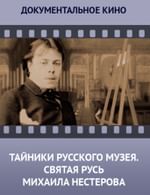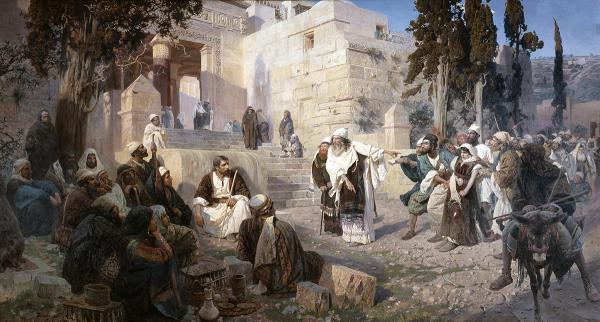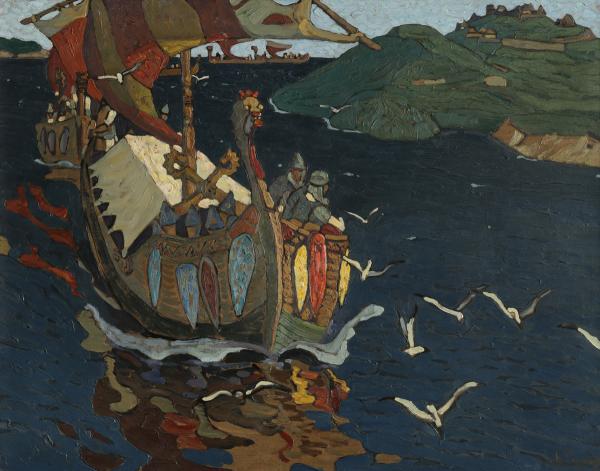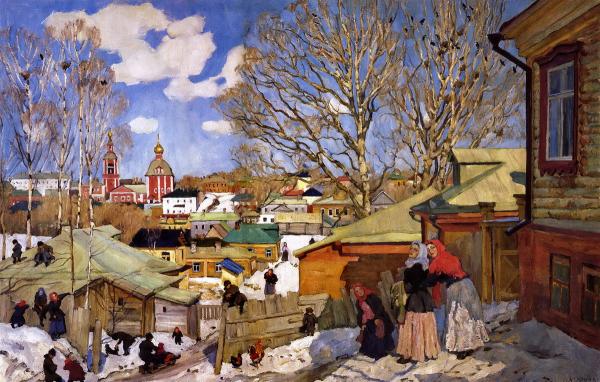The artist is Nesterov
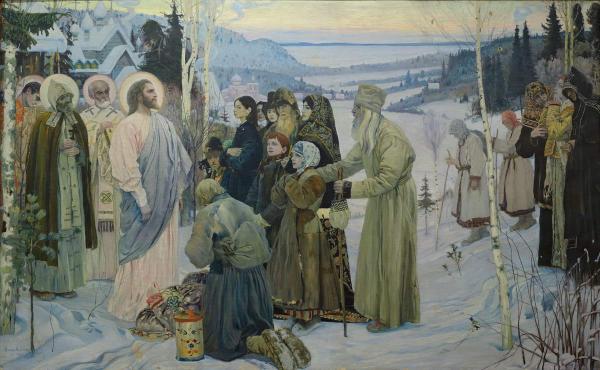
A trip to the Solovetsky Islands (on the White Sea) and acquaintance with the monastery life played an important role in the life and work of the artist. Impressed by the Russian North, the harsh nature and Solovetsky monks paints are painted by the artist "Silence", "Fox", "Quiet life", "The monastery of Solovetskaya", "The dreamers", "Solovki". The purpose of the trip was to work on a large software work "Holy Rus’", The second name was the initial lines of the Nagorus sermon of Christ "Come to me all the working and burdened, and I will rest you; Take my yoke on yourself and learn from me, for I am a meek and humble with my heart, and you will find peace of your souls; for my yoke is my good and my burden is easy". The picture was supposed to become the result of many years of work and religious and philosophical thoughts of the artist.
The action takes place against the background of the northern winter landscape. To Christ, surrounded by the most revered by the holy intercessors – Nikolai, Sergius and George, the pilgrims came. On the basis of field sketches on Solovki and in Khotkovo, the artist managed to create convincing images of the assembled. Here you can see people especially close to the author. The prototypes of female images were the mother of the artist (in the picture of the schema-monkhin), his sister (woman in a carpet) and a nanny (a woman in a scarf in the center of the picture, with her appearance, the master connected her idea of the Russian beauty).
The images of Christ and saints seem to have come down from the walls of temples, whose paintings Nesterov, by his own admission, gave fifteen years of his life. (Nesterov, together with other artists, worked in the Vladimir Cathedral in Kyiv, in the temples of the Marfo-Mariinsky monastery in Moscow and in Abastuman in the Caucasus). This work played an important role in the fate of the painter. During the first show, Ekaterina Petrovna Vasilieva, who came to see her, who had not yet finished, became a wife after a few months. Nesterova.
Show the full text
Hide the full text
In the second half of the 1890s, the period of the most intensive religious and ethical searches of Nesterov came: he conceived his first software canvas-“Holy Rus’”, and his acquaintance with modern Russian philosophical thought found purposefulness.
The idea of “Holy Rus’” as a “big”, final picture, of course, went back to the tradition of the 19th century, primarily to Alexander Ivanov, whose life and work were for Nesterov the highest and unattainable model. Actually, the theme of “Holy Rus’” is the theme of the Ivanovo “The Phenomenon of Christ The People” (1833–1857, GTG), which it introduced to the Russian Orthodox intelligence artist of the pre-revolutionary era. Real Russia, which was rapidly filled with revolutionaries, rebels and nihilists, he tried to oppose her “intelligible” image – Rus’ longing for righteousness, Rus’ of wanderers and praying people, beggars and sufferers, monks and saints. Philosopher Ivan Ilyin, spiritually very close to Nesterov, later wrote: “Rus’ is called „the holy “not because there are no holiness in other countries; This is not our pride and not self -supervision . Rus’ is called „the holy “And not because in it „There is no “sin and vice; Or what is in it „All “people are saints, but because it lives deep, never exhausted, but, in sinful people of people, and not a quenching thirst for righteousness, the dream of approaching it, mentally leaning before her, artistically identify with it, become at least weak She was a gleam . And in this thirst for righteousness a person is right and holy . When we are talking about „Holy Rus’ ", then not in order to close his eyes to these limits of human nature and naively and proudly idealize their people; but in order to affirm that next to the unaccounted Russia (and even in the same soul!) There was always Holy Rus’, prayerly harassed to the Lord and reached him seeing. ".
The emergence of the final sketch of “Holy Rus’” was in 1900, the very turn of the centuries, and the completion of work on the picture and its presentation to the court of the general public-respectively 1905 and 1907-coincided with the events of the Russian-Japanese war and the first Russian revolution. Now this fact seems symbolic and hardly simple chance. He testifies to the civil sensitivity of the artist who realized that Russia in the 20th century is in the face of huge events. How important Nesterov attached importance to his new work, quotes from his letters testify to: “I diligently work sketches for my future picture, to the picture, where I hope to bring the results of my best thoughts, the best part of myself”; “The picture is complicated in all respects, after it, although in peace, everything will be said” and so on.
Nesterov has been engaged in the search for materials for "Holy Rus’" since the late 1890s. Of great importance for the work on the picture were the artist’s creative trips in the Moscow Region and especially Solovki, where he could personally observe the ascetic, passing in works and prayers, the life of the monks, to admire the harsh grandeur of northern nature, to study the diverse and expressive types of pilgrims.
The composition "Holy Rus’" breaks up into two parts. The right, mostly part, occupies the images of the pilgrims who came to Christ. Each of these characters is distinguished by a deep personality, the originality of the psychological state. At one time, Nesterov believed to introduce Maxim Gorky into the picture of Maxim Gorky – a talented native of social lower. He made a portrait study from him and even outlined his face on the canvas (in the center in the background). But after the publication of Gorky’s poem “Man” (1904), imbued with the revolutionary and nitrian spirit, and the final transition of the writer to the radical camp Nesterov replaced his image with the image of the sister of mercy of Kobchevskaya, who served before the model for the Abasturian image of the Holy Nina.
In Nesterov, the left side of the canvas with images of Christ and saints turned out to be much less expressive. The image of Christ came out with the artist cold-to-strict-strict, even arrogant. The feeling of figurative unconvincing was supplemented by the character of the figure – dense and carnal, neatly draped according to academic rules. As for the images of the saints, almost unchanged by Nesterov to the picture from the walls of the Alexander Nevsky Church in Abastuman, then with all his beauty and effectiveness, next to the people from flesh and blood, against the backdrop of a well-written winter Russian landscape, they seem artificial, fake. The combination of “material” and “ideal” turned into “holy Rus’” with eclecticism, a mixing of stylistic elements, because it was not mediated by the organicity of their joint experience. Nesterov realized the failure that befell him with the image of Christ almost immediately after the end of work on the picture. Many years later, explaining his plan, he said: “I did not want to write a relaxed Christ, dull, as they loved to write then . I have dull and relaxed. And he must be different ".
Nesterov was looking forward to an assessment in. AT. Rozanova, whose intuition and the depth of comprehension of the subject put unusually high. Rozanov saw “Holy Rus’” at the artist’s personal exhibition in St. Petersburg. The impression of the picture was as follows: “Nesterov is not icon painting. It is not his business to write „God ", only „How a person resorts to God ". On his large canvas „Holy Rus’ “This affected the extraordinary brightness! The left side where the Savior stand and behind him „Particularly revered “in Rus’ saints – I want to close this part with my hands . But, closing or discarding this left part, you almost indulge in exclamations, looking at the right, main, almost occupying the entire canvas . This is praying Rus’!""
Pavel Klimov. "The trilogy about Holy Rus’ // Mikhail Nesterov. SPb, 2012. With. 164-166.
We recommend
|
|
Master class "Mikhail Nesterov „Holy Rus’ ". Stages and restoration process ". O. YU. Klenova, Russian Museum. October 30, 2020 |
|
|
|
The film "M. AT. Nesterov. Holy Rus’. 1905. Restoration. 2019 ". From the online program of the Russian Museum "Profession – Restorer" |
|
|
|
Holy Rus’ Mikhail Nesterov. Documentary from the cycle "Caches of the Russian Museum" (2013) |
|
 |
Mikhail Nesterov. "The Omen". Biblical plot (neophyte studio) |


